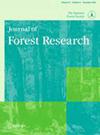Land-cover changes and deforestation drivers in the forest landscape of Banmauk township in the Sagaing Region of upper Myanmar
IF 1.1
4区 农林科学
Q3 FORESTRY
引用次数: 0
Abstract
ABSTRACT This study focused on the extent of land-cover changes and prediction of probable factors in deforestation based on changes observed from 2000 to 2021 in the forest landscape of Banmauk Township in Myanmar’s Sagaing Region. Landsat 7 ETM+ and Landsat 8 OLI satellite imagery were used to identify seven land-cover classes via supervised random tree classification, and binary logistic regression analysis was used to predict the potential for biophysical and locational factors to affect deforestation. A stratified random sampling method was used to assess the accuracy of the classified maps and to estimate the areas. The study revealed that dense forest coverage decreased from 45.65% in 2000 to 29.01% in 2021, while open forest areas increased from 49.33% to 54.51%. Mining areas exhibited a considerable increase from 0.37% to 5.35%, while settlement and barren/scrub land areas increased from 0.16% to 0.51% and 1.71% to 7.70%, respectively. Agricultural areas slightly increased from 2.11% to 2.33%, while water areas remained almost the same at around 0.60%. Post-classification change detection analysis showed that deforestation occurred mainly through converting forest land to mining and barren/scrub land. The study indicated that lower altitudes and road accessibility are significantly associated with the potential for deforestation.缅甸上实皆地区Banmauk镇森林景观中的土地覆盖变化和森林砍伐驱动因素
摘要本研究基于2000年至2021年在缅甸实皆地区Banmauk镇森林景观中观察到的变化,重点研究了土地覆盖变化的程度以及森林砍伐的可能因素的预测。Landsat 7 ETM+和Landsat 8 OLI卫星图像用于通过监督随机树分类确定七个土地覆盖类别,并使用二元逻辑回归分析预测生物物理和位置因素影响森林砍伐的潜力。使用分层随机抽样方法来评估分类地图的准确性并估计面积。研究显示,茂密的森林覆盖率从2000年的45.65%下降到2021年的29.01%,而开阔的森林面积从49.33%增加到54.51%。采矿区从0.37%大幅增加到5.35%,而定居地和贫瘠/灌木丛面积分别从0.16%增加到0.51%和1.71%增加到7.70%。农业面积从2.11%略微增加到2.33%,而水域面积几乎保持不变,约为0.60%。分类后变化检测分析表明,森林砍伐主要是通过将林地转变为采矿和贫瘠/灌木丛而发生的。研究表明,海拔较低和道路可及性与森林砍伐的可能性密切相关。
本文章由计算机程序翻译,如有差异,请以英文原文为准。
求助全文
约1分钟内获得全文
求助全文
来源期刊

Journal of Forest Research
农林科学-林学
CiteScore
3.00
自引率
6.70%
发文量
62
审稿时长
3 months
期刊介绍:
Journal of Forest Research publishes original articles, reviews, and short communications. It covers all aspects of forest research, both basic and applied, with the aim of encouraging international communication between scientists in different fields who share a common interest in forest science.
 求助内容:
求助内容: 应助结果提醒方式:
应助结果提醒方式:


